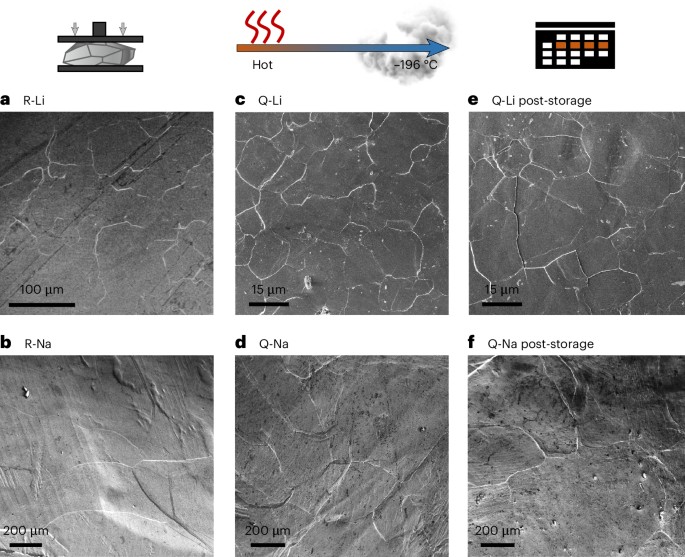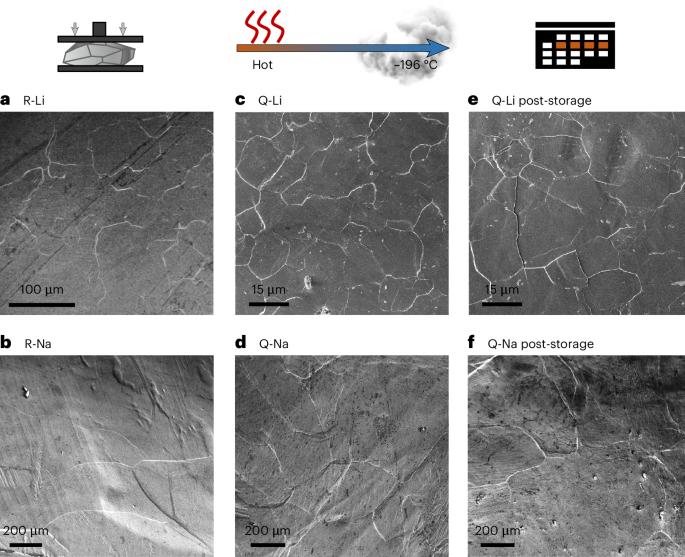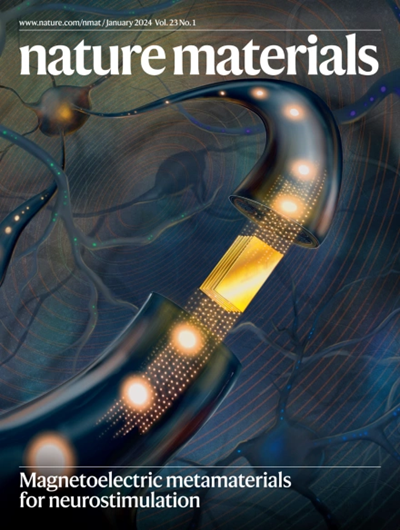利用电子反向散射衍射成像无阳极固态电池中锂和金属钠的微观结构
IF 38.5
1区 材料科学
Q1 CHEMISTRY, PHYSICAL
引用次数: 0
摘要
无阳极 "电池,或者更贴切地说,无金属储层电池,可以通过实现更高的能量密度、提高安全性和简化制造过程,极大地改进当前的固态电池技术。迄今为止,已报道了多种策略来控制电沉积碱金属薄膜的形态,使其均匀致密,但到目前为止,电沉积碱金属的微观结构尚不清楚,也没有找到合适的表征途径。在此,我们建立了一个可重复的方案,通过聚焦离子束和电子反向散射衍射相结合的方法,表征不同处理方式的锂和钠样品中金属晶粒的尺寸和取向。对 Cu|Li6.5Ta0.5La3Zr1.5O12、Steel|Li6PS5Cl 和 Al|Na3.4Zr2Si2.4P0.6O12 界面的电沉积薄膜进行了表征。分析结果表明,这些薄膜中的晶粒尺寸较大(100 微米),晶界有优先取向。此外,我们还利用原位电子反向散射衍射对金属的生长和溶解进行了研究,结果表明在电沉积过程中晶粒会发生动态粗化,在溶解过程中晶粒内部会形成孔隙。我们的研究方法和结果深化了通过表征碱金属微观结构来提高固态电池性能的研究领域。本文章由计算机程序翻译,如有差异,请以英文原文为准。


Imaging the microstructure of lithium and sodium metal in anode-free solid-state batteries using electron backscatter diffraction
‘Anode-free’ or, more fittingly, metal reservoir-free cells could drastically improve current solid-state battery technology by achieving higher energy density, improving safety and simplifying manufacturing. Various strategies have been reported so far to control the morphology of electrodeposited alkali metal films to be homogeneous and dense, but until now, the microstructure of electrodeposited alkali metal is unknown, and a suitable characterization route is yet to be identified. Here we establish a reproducible protocol for characterizing the size and orientation of metal grains in differently processed lithium and sodium samples by a combination of focused ion beam and electron backscatter diffraction. Electrodeposited films at Cu|Li6.5Ta0.5La3Zr1.5O12, steel|Li6PS5Cl and Al|Na3.4Zr2Si2.4P0.6O12 interfaces were characterized. The analyses show large grain sizes (>100 µm) within these films and a preferential orientation of grain boundaries. Furthermore, metal growth and dissolution were investigated using in situ electron backscatter diffraction, showing a dynamic grain coarsening during electrodeposition and pore formation within grains during dissolution. Our methodology and results deepen the research field for the improvement of solid-state battery performance through a characterization of the alkali metal microstructure. The microstructure of alkali metals in anode-free cells is currently unknown. Here, using a combination of focused ion beam and electron backscatter diffraction, this morphology is investigated, with in situ scanning electron microscopy showing dynamic grain coarsening during electrodeposition.
求助全文
通过发布文献求助,成功后即可免费获取论文全文。
去求助
来源期刊

Nature Materials
工程技术-材料科学:综合
CiteScore
62.20
自引率
0.70%
发文量
221
审稿时长
3.2 months
期刊介绍:
Nature Materials is a monthly multi-disciplinary journal aimed at bringing together cutting-edge research across the entire spectrum of materials science and engineering. It covers all applied and fundamental aspects of the synthesis/processing, structure/composition, properties, and performance of materials. The journal recognizes that materials research has an increasing impact on classical disciplines such as physics, chemistry, and biology.
Additionally, Nature Materials provides a forum for the development of a common identity among materials scientists and encourages interdisciplinary collaboration. It takes an integrated and balanced approach to all areas of materials research, fostering the exchange of ideas between scientists involved in different disciplines.
Nature Materials is an invaluable resource for scientists in academia and industry who are active in discovering and developing materials and materials-related concepts. It offers engaging and informative papers of exceptional significance and quality, with the aim of influencing the development of society in the future.
 求助内容:
求助内容: 应助结果提醒方式:
应助结果提醒方式:


